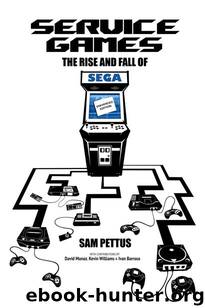Service Games: The Rise and Fall of SEGA: Enhanced Edition by Sam Pettus & David Munoz & Kevin Williams & Ivan Barroso

Author:Sam Pettus & David Munoz & Kevin Williams & Ivan Barroso [Pettus, Sam & Munoz, David & Williams, Kevin & Barroso, Ivan]
Language: eng
Format: epub
Tags: Games, Video & Electronic
ISBN: 9781311080820
Google: DbFxAgAAQBAJ
Published: 2013-12-20T20:31:50.420763+00:00
Mock Sega-Bandai logo
So what was the big deal? How were lower-level personnel at Bandai able to spike the merger? There were several smaller reasons that – when combined as a whole – predicated impending disaster to critics of Nakayama and Yamashina's plans. First was Sega itself: A company already on shaky financial ground and that stood to gain more from the merger with Bandai, with whom it had little in common. Second was their respective corporate cultures: Sega had a rather loose-knit, free-wheeling management style largely credited to its origins as an American entrepreneurial enterprise, while Bandai was a traditional Japanese company which operated along strict Japanese cultural lines. Third was Nakayama himself: He was not perceived as an ideal choice to run such a large company due the manner in which he was running Sega into the ground right before everybody's eyes. Fourth was a sudden turn of good fortune for Bandai: One of their new toy products – a virtual pet device called tamogatchi – was proving to be a big success, and looked to generate sufficient revenue in the near future to make up what losses the company was currently incurring. Boiling it all down left many with a clear conclusion: Bandai didn't need Sega. Sega needed Bandai, who may have been the one posting a loss for fiscal year 1996, but had the merchandising strength to rebound. Sega didn't and never would. Bandai was always the deciding partner in the merger, and both Sega's and Nakayama's future success hinged on whether or not it went through. On May 28, 1997, as news about the failure of the merger was breaking, the following observation – shared by a number of financial market analysts – was posted on Dave's Sega Saturn Page.
“In the long-term, Sega may have more to lose from the failed merger as it had become much harder to restructure its unprofitable game-machine operation without new blood and a boost in its earnings. They said Sega's video-game machine is losing money and is unlikely to turn profitable in the future.”
Nakayama was never able to bring Sega back into a position of market strength. The planned merger with Bandai had been his last throw of the dice. As 1997 rolled on, he quietly began making preparations to leave. On January 12, 1998, Nakayama tendered his resignation as chief operating officer of Sega of Japan. "Many speculate that the move by Nakayama is to take responsibility for the failed merger between Sega and Bandai, and the less than spectacular business achievements of Sega this past year," reported GameSpot News. The resignation became official the following month; Nakayama was booted upstairs to the newly created ceremonial office of corporate vice-chairman, and fellow executive Shoichiro Irimajiri was appointed by the stockholders as the new Sega CEO. By June, Nakayama had left Sega altogether. He was the last of Sega's founding management team to leave, and his departure ended a long and often dictatorial era in the company's storied history.
In the West, Bernie Stolar is the man most often blamed by Sega diehards for the death of the Saturn.
Download
This site does not store any files on its server. We only index and link to content provided by other sites. Please contact the content providers to delete copyright contents if any and email us, we'll remove relevant links or contents immediately.
Bad Blood by John Carreyrou(6559)
Rich Dad Poor Dad by Robert T. Kiyosaki(6415)
Principles: Life and Work by Ray Dalio(6236)
Playing to Win_ How Strategy Really Works by A.G. Lafley & Roger L. Martin(5945)
Management Strategies for the Cloud Revolution: How Cloud Computing Is Transforming Business and Why You Can't Afford to Be Left Behind by Charles Babcock(4528)
The Confidence Code by Katty Kay(4193)
Thinking in Bets by Annie Duke(4154)
American Kingpin by Nick Bilton(3762)
Delivering Happiness by Tony Hsieh(3369)
Project Animal Farm: An Accidental Journey into the Secret World of Farming and the Truth About Our Food by Sonia Faruqi(3179)
The Power of Habit by Charles Duhigg(3064)
The Tyranny of Metrics by Jerry Z. Muller(3008)
Brotopia by Emily Chang(3002)
Mastering Bitcoin: Programming the Open Blockchain by Andreas M. Antonopoulos(2986)
The Marketing Plan Handbook: Develop Big-Picture Marketing Plans for Pennies on the Dollar by Robert W. Bly(2979)
I Live in the Future & Here's How It Works by Nick Bilton(2941)
The Content Trap by Bharat Anand(2864)
Building a StoryBrand by Donald Miller(2844)
Applied Empathy by Michael Ventura(2839)
